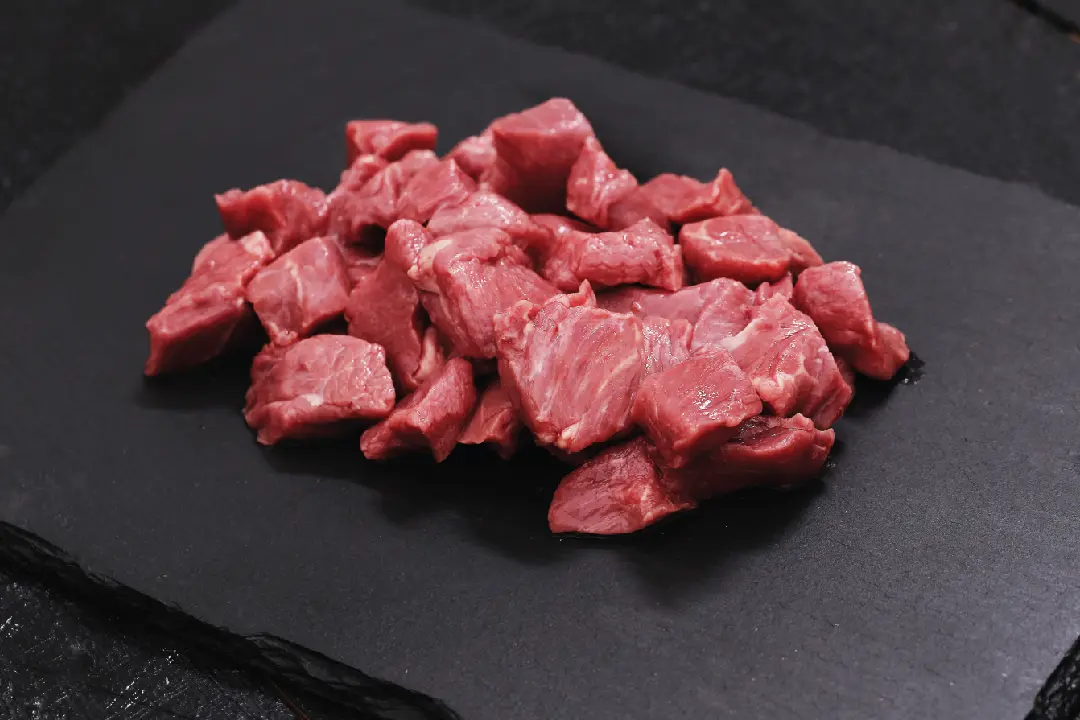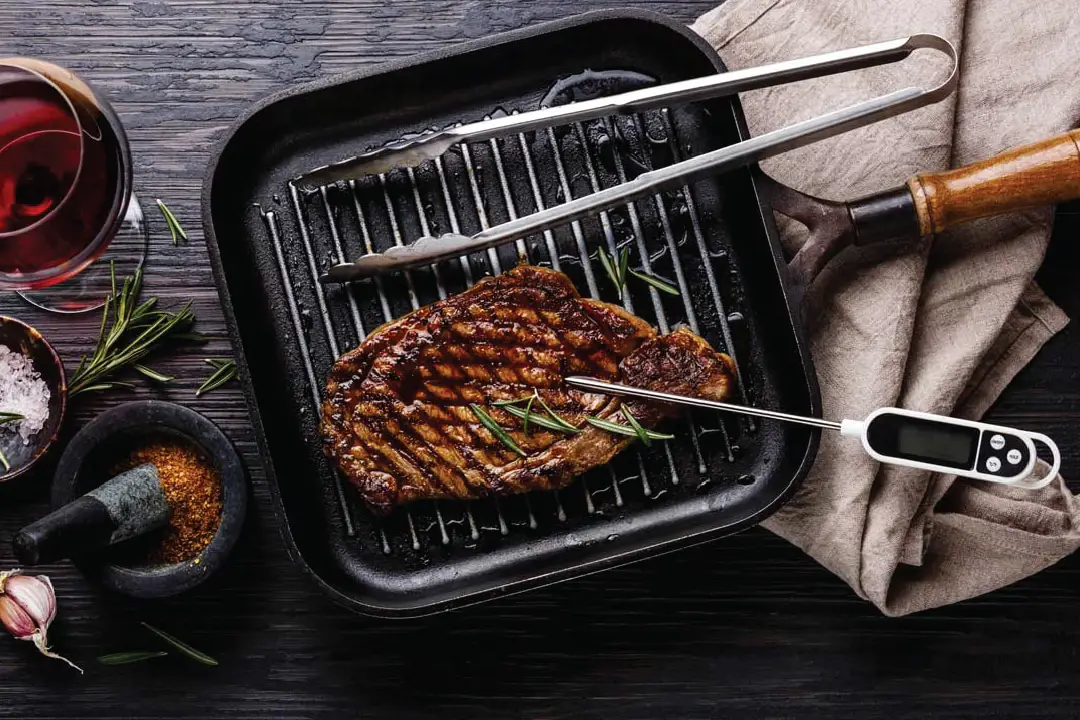You can look back on it in years to come, and the smile will come back to your lips, and to the lips of everyone with whom you shared that experience.
Get it wrong though, and you’ll never speak of it again. You’ll add your name to the Book of Grilling Cliché, as one who should never be allowed near a pair of tongs again. If you serve prime rib that’s crusted and succulent on the outside, but still gelatinous and blue on the inside, people will tackle you like a football player to stop you from getting your hands on the grill again.
And that’s if you’re lucky. Because cooking meat to the wrong temperature can have consequences far beyond a mouthful of what-am-I-eating-here? Some of our most popular meats contain bacteria in their raw form that need precise and thorough cooking to kill, so they’re safe for human consumption. Cook your meat to the wrong temperature and you – and everyone you feed with it – could be at risk of anything from a Bad Day in The Bathroom, through to death. Yes, actual death. No, that’s not just media panic put about by Gordon Ramsay and Top Chef. You can literally die from incorrectly cooked meat.
And whereas some bacteria are likely to be already in some popular meats and need killing by the correct cooking process, other meats are made more dangerous than they otherwise would be by the processes of getting it from hoof or claw to your grill.
Step right up, it’s time to play Wheel! Of! Bacterial Death!
Flippant?
Sure, but to a purpose. Meat can be gorgeous. It can make your taste buds sizzle and sear itself into your memory as a great experience.
But for that to happen, you have to take meat just a little seriously. You have to go into the grilling and cooking process with respect. Respect for the animal that was alive till you got hungry. Respect for your own life, and the lives of those you’re feeding.
That means cooking your meat right.
You can cook some meats bloody as hell if you like, or you can char them till they’re tasty, chewy hockey pucks. That’s on you and your personal taste. But cook it till it’s safe, for sure, and then cook it so you get the results you want from it, wherever on the cooking spectrum you sit.
Know your temperatures and you can get those results every time. Cooking meat is not rocket science. By the time you tear your eyes away from this page, you’ll know what to do and where to aim to get any grilling result you want.
The Scary Stuff – What Can Happen If You Eat Undercooked Meats

You’re going to want to pull on your big pants for this section. We’re not out to needlessly scare you about every mouthful of food you eat – we promise. But if we’re going to understand why it’s important to cook meat to the correct temperatures…we need to be armed with knowledge. Buckle up – we’re going down to a microscopic level, where things wriggle, and squirm, and teem. The level where things are so gruesome they can only be described in dead languages like Latin, and where things need killing if they’re not to kill you right back.
Let’s follow the example of those sons of fun, the Center for Disease Control, and break this down into meat groups. Let’s start with the Big Four: Chicken, Beef, Pork, and Turkey.
Chicken, Beef, Pork, And Turkey

Raw meat in the 21st century, once it’s been through its life and death and processing to end up at your local supermarket (or farmer’s market – no, there’s little by way of improvement just because it’s ‘organic.’ Sorry) is – or can be a rich gumbo of potentially hazardous bacterial life. If you don’t cook it well enough, to the right temperature to kill all of these potential pests, you could be putting this roll call of joy into your system:
Campylobacter – causes an estimated 1.5 million cases of illness in the US every year.
What kind of illness?
So glad you asked.
Diarrhea (often bloody), fever, and stomach cramps. For starters. Sometimes, just for extra fun, nausea and vomiting join in the chorus of bathroom woe.
Symptoms usually start between 2-5 days after infection and last about one week.
That, friends, is one hell of a week.
For all we may sound flippant, this is nothing whatsoever to take lightly. And here’s the kicker. Most people recover from Campylobacter on their own, while some others need antibiotics procured from them by a friend or relative because there’s no way you’re driving your explosive cramping stomach to the pharmacy.
Some people experience complications from campylobacter, such as irritable bowel syndrome, temporary paralysis, and arthritis.
In some extremely unlucky people with weakened immune systems – whether from blood disorders, AIDS, or being treated with chemotherapy – campylobacter gets into the bloodstream and causes a life-threatening infection.
Not fun. This is Reason #1 why Chicken Tartare is not on any menu, anywhere. Eat pink chicken, you’re spinning the Wheel Of Bathroom Nightmares, and it could even kill you.
Campylobacter, perversely enough, is one of the less serious, or at least less fatal, bacteria you might encounter from undercooked chicken – and indeed, other undercooked meats. It is, however, the one that’s most likely to be in most raw chicken. Place your bets…
That was just the first thing that could be hiding on your undercooked chicken. We did say you were gonna need your big pants for this section.
Salmonella – Causes an estimated 1.35 million infections in the US each year. Of those, it leads to around 26,500 hospitalizations and 420 deaths. You can get salmonella from other sources, but food is by far the biggest cause of transmission.
Symptoms? Remarkably similar to those of campylobacter – diarrhea, fever, stomach cramps. You can get the symptoms much faster with salmonella, though – anything from 6 hours to 6 days after eating the contaminated food. And in most cases of salmonella, you shouldn’t take antibiotics. Which can be tricky, because telling it apart from campylobacter, which in some cases can respond to antibiotics, can be tricky. There’s also no reason why both bacterial organisms shouldn’t be on the same piece of undercooked meat.
Clostridium perfringens – really doesn’t play fair. It’s a bacteria, and the chances are it’s alive and kicking in your gut right now. It’s a native of the human digestive system as well as those of other animals. But eating meat contaminated with Clostridium perfringens from outside can cause your digestive system to do star jumps. Again with the diarrhea, again with the cramping, and again with the symptoms within 6-24 hours. On the up-side, there’s no fever or vomiting with Clostridium perfringens, and it usually doesn’t last longer than 24 hours.
When people say they’ve had a 24-hour ‘stomach flu,’ there’s a good chance that what they’ve actually had is Clostridium perfringens.
Incidentally, if you’re wondering how an intestinal tract bacteria gets onto meat sold in stores…you probably don’t want to know about US slaughterhouse policies in great detail, just maybe take our word for it. The insides get out.
Coli – Speaking of the insides getting out, welcome to E. Coli. Like Clostridium perfringens, we have it in our intestines, as do other animals. E.Coli is actually a collective name for six types of similar bacteria. And cue the (often bloody) diarrhea, the stomach cramps, the vomiting. Usually, people will recover from E. Coli within 5-7 days, and fever is not a particular symptom, but can sometimes accompany the infection.
So, a week of deep unpleasantness. Worth avoiding, but not up there with the fatal bacteria, right?
Well…
Around 5–10% of people who get E.Coli go on to develop a complication called hemolytic uremic syndrome (HUS). How do you know if you have that? Exhaustion, reduced frequency of urination, and the color in your cheeks drains out. If that happens to you – get to a hospital. You could be looking at kidney malfunction or shutdown. Most people who get HUS recover within a couple of weeks. But not all. Some suffer permanent damage. Some others…don’t suffer it for long.
All these infections can be killed or minimized by proper food handling and cooking.
So, fish and seafood, then?
You might think so, but fish and seafood are just as susceptible to bacteria that can make you sick. There are also issues with parasites, mercury, and accidental thawing in transit.
Leave fish or shellfish out for more than 2 hours, and you might as well throw it away. There are Mercury issues with some fish and shellfish, but there’s not a great deal you can do about that. For everything else though, there are basic food hygiene tips to adhere to. Buy fresh if possible. Look for movement from any crustaceans (crab, lobster), because they deteriorate rapidly after death. Tap mussels to make sure they react and close up. If they don’t open up during cooking, discard them, they’re dangerous.
And then – and this really can’t be stressed too highly – cook them to the right temperature to kill any bacteria.
So What’s the Right Temperature?

When you fire up your grill, before you start worrying about cooking meat and fish the way you and your guests most enjoy it, your first job is to not kill anyone.
For that, you need to hit a minimum internal temperature. That minimum internal temperature varies from meat to meat.
According to the CDC, the following is what you’re aiming for as a safe minimum.
Read more...
Author
Jimmy Watts
Article and images reproduced with permission from Own the Grill
Please view the full article here






